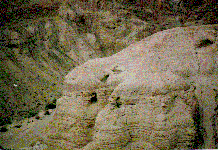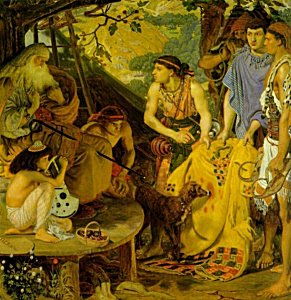Mišvikudagur, 8. įgśst 2007
Daušahafshandritin
Langt inn ķ hellunum ķ Qumran eru žannig ekki ašeins elstu žekktu handrit Gamla testamentisins į hebresku, heldur einnig aš öllum lķkindum eru žau elstu handrit sem hafa fundist žar į mešal mį nefna the Book Of Enoch & The Book Of Jubbilees & hin duldu handrit dead sea scroll voru uppgötvuš į milli 1947-1956 ķ 11 helli (5 ķ ... Inn ķ helli 3, (ekki ašeins fundust žau grķsku śr helli 7.p.s fer betur ķ žau seinna .safn į 800-900 skjölum handritum .http://www.bl.uk/onlinegallery/sacredtexts/deadseascrolls.htmlhtml

The Book of Jubilees
From "The Apocrypha and Pseudepigrapha of the Old Testament"
R.H. Charles
Oxford: Clarendon Press, 1913
INTRODUCTION
1. SHORT ACCOUNT OF THE BOOK.

The Book of Jubilees is in certain limited aspects the most important book in this volume for the student of religion. Without it we could of course have inferred from Ezra and Nehemiah, the Priests' Code, and the later chapters of Zechariah the supreme position that the law had achieved in Judaism, but without Jubilees we could hardly have imagined such an absolute supremacy as finds expression in this book. This absolute supremacy of the law carried with it, as we have seen in the General Introduction, the suppression of prophecy -at all events of the open exercise of the prophetic gifts. And yet these gifts persisted during all the so-called centuries of silence-from Malachi down to N.T. times, but owing to the fatal incubus of the law these gifts could not find expression save in pseudepigraphic literature. Thus Jubilees represents the triumph of the movement, which had been at work for the past three centuries or more.
And yet this most triumphant manifesto of legalism contained within its pages the element that was destined to dispute its supremacy and finally to reduce the law to the wholly secondary position that alone it could rightly claim. This element of course is apocalyptic, which was the source of the higher theology in Judaism, and subsequently was the parent of Christianity, wherein apocalyptic ceased to be pseudonymous and became one with prophecy.
The Book of Jubilees was written in Hebrew by a Pharisee between the year of the accession of Hyrcanus to the high priesthood in 135 and his breach with the Pharisees some years before his death in 105 B.C. It is the most advanced pre-Christian representative of the midrashic tendency, which has already been at work in the Old Testament Chronicles. As the Chronicler had rewritten the history of Israel and Judah from the basis of the Priests' Code, so our author re-edited from the Pharisaic standpoint of his time the history of events from the creation to the publication, or, according to the author's view, the republication of the law on Sinai. In the course of re-editing he incorporated a large body of traditional lore, which the midrashic process had put at his disposal, and also not a few fresh legal enactments that the exigencies of the past had called forth. His work constitutes an enlarged Targum on Genesis and Exodus, in which difficulties in the biblical narrative are solved, gaps supplied, dogmatically offensive elements removed, and the genuine spirit of later Judaism infused into the primitive history of the world. His object was to defend Judaism against the attacks of the hellenistic spirit that had been in the ascendant one generation earlier and was still powerful, and to prove that the law was of everlasting validity. From our author's contentions and his embittered attacks on the paganisers and apostates, we may infer that Hellenism had urged that the levitical ordinances of the law were only of transitory significance, that they had not been observed by the founders of the nation, and that the time had now come for them to be swept away, and for Israel to take its place in the brotherhood of the nations. Our author regarded all such views as fatal to the very existence of Jewish religion and nationality. But it is not as such that he assailed them, but on the ground of their falsehood. The law, he teaches, is of everlasting validity. Though revealed in time it was superior to time. Before it had been made known in gundry portions to the fathers it had been kept in heaven by the angels, and to its observance henceforward there was no limit in time or in eternity.
Writing in the palmiest days of the Maccabean dominion,in the high-priesthood of John Hyrcanus, looked for the immediate advent of the Messianic kingdom. This kingdom was to be ruled over by a Messiah sprung, not from Levi -that is, from the Maccabean family, as some of his contemporaries expected- but from Judah. This kingdom would be gradually realized on earth, and the transformation of physical nature would go hand in hand with the ethical transformation of man till there was a new heaven and a new earth. Thus, finally, all sin and pain would disappear and men would live to the age of 1,000 years in happiness and peace, and after death enjoy a blessed immortality in the spirit world.
2. VARIOUS TITLES OF THE BOOK.
Our book was known by two distinct titles even in Hebrew. (a) Jubilees
(b) The Little Genesis
(c) Apocalypse of Moses and other alleged names of the book.
(a) Jubilees. This appears from Epiphanius (Haer. xxxix. 6) to have been its usual designation. It is found also in the Syriac Fragment entitled 'Names of the Wives of the Patriarchs according to the Hebrew Book of Jubilees,' first published by Ceriani, Mon. sacra et profana, ii. 1.9-10, and reprinted by the present writer in his edition of The Ethiopic Version of the Hebrew Book of Jubilees. This name admirably describes the book, as it divides into jubilee periods of forty-nine years each the history of the world from the creation to the legislation on Sinai. The writer pursues a perfectly symmetrical development of the heptadic system. Israel enters Canaan at the close of the fiftieth jubilee, i.e. 2450.
(b) The Little Genesis. The epithet 'little' does not refer to the extent of the book, for it is larger than the canonical Genesis, but to its character. It deals more fully with details than the biblical work. The Hebrew title was variously rendered in Greek. 1 [(Gk.) he lepte Genesis (or Lepte Genesis)] as in Epiphanius, Syncellus, Zonaras, Glycas. 2 [(Gk.) he Leptogenesis] in Didymus of Alexandria and in Latin writers, as we may infer from the Decree of Gelasius. 3 [Gk.) ta lepta geneseos] in Syncellus. 4 [(Gk.) Mikrogenesis] in Jerome, who was acquainted with the Hebrew original.
(c) 1 The Apocalypse of Moses.
2 The Testament of Moses.
3 The Book of Adam's Daughters.
4 The Life of Adam.
1 The Apocalypse of Moses. This title had some currency in the time of Synceflus (see i. 5, 49). It forms an appropriate designation since it makes Moses the recipient of all the disclosures in the book. 2 The Testament of Moses. This title is found in the Catena of Nicephorus, i. 175, where it precedes a quotation from x. 21 of our book. It has, however, nothing to do with the Testament of Moses, which has become universally known under the wrong title -the Assumption of Moses. Ronsch and other scholars formerly sought to identify Jubilees with this second Testament of Moses, but this identification is shown to be impossible by the fact that in the Stichometry of Nicephorus 4,300 stichoi are assigned to Jubilees and only 1100 to this Testament of Moses. On the probability of a Testament of Moses having been in circulation -which was in reality an expansion of Jubilees ii-iii see my edition of Jubilees, p. xviii. 3 The Book of Adam's Daughters. This book is identified with Jubilees in the Decree of Gelasius, but it probably consisted merely of certain excerpts from Jubilees dealing with the names and histories of the women mentioned in it. Such a collection, as we have already seen, exists in Syriac, and its Greek prototype was used by the scribe of the LXX MS. no.135 in Holmes and Parsons' edition. 4 The Life of Adam. This title is found in Syncellus i. 7-9. It seems to have been an enlarged edition of the portion of Jubilees, which dealt with the life of Adam.
http://www.ccel.org/ccel/charles/otpseudepig/jubilee/1.htm
Flokkur: Trśmįl og sišferši | Breytt 2.1.2008 kl. 13:30 | Facebook


 Bryndís Böðvarsdóttir
Bryndís Böðvarsdóttir
 Rósa Aðalsteinsdóttir
Rósa Aðalsteinsdóttir
 Jón Valur Jensson
Jón Valur Jensson
 Janus Hafsteinn Engilbertsson
Janus Hafsteinn Engilbertsson
 Mofi
Mofi
 halkatla
halkatla
 G.Helga Ingadóttir
G.Helga Ingadóttir
 Tryggvi Hjaltason
Tryggvi Hjaltason
 Birna M
Birna M
 Helena Leifsdóttir
Helena Leifsdóttir
 Predikarinn - Cacoethes scribendi
Predikarinn - Cacoethes scribendi
 Sunna Dóra Möller
Sunna Dóra Möller
 Friðrik Páll Friðriksson
Friðrik Páll Friðriksson
 Gústaf Níelsson
Gústaf Níelsson
 Snorri Bergz
Snorri Bergz
 Gunnlaugur Halldór Halldórsson
Gunnlaugur Halldór Halldórsson
 Sigurður Sigurðsson
Sigurður Sigurðsson
 Svavar Alfreð Jónsson
Svavar Alfreð Jónsson
 Kristján Björnsson
Kristján Björnsson
 Guðrún Sæmundsdóttir
Guðrún Sæmundsdóttir
 Högni Hilmisson
Högni Hilmisson
 Andrea J. Ólafsdóttir
Andrea J. Ólafsdóttir
 Karl V. Matthíasson
Karl V. Matthíasson
 Sigríður Jónsdóttir
Sigríður Jónsdóttir
 Ingibjörg
Ingibjörg
 Alfreð Símonarson
Alfreð Símonarson
 Óskar Helgi Helgason
Óskar Helgi Helgason
 Jón Steinar Ragnarsson
Jón Steinar Ragnarsson
 Brynjólfur Þorvarðsson
Brynjólfur Þorvarðsson
 Sigurður Þórðarson
Sigurður Þórðarson
 Aida.
Aida.
 Ólafur Jóhannsson
Ólafur Jóhannsson
Athugasemdir
Takk fyrir fróšleikinn
Gušrśn Sęmundsdóttir, 8.8.2007 kl. 22:56
Hę Hę gaman aš hafšir gaman af fróšleiknum Gśšrśn ég ętla kynna žessar bękur hérna betur eins Book of enoch +fleiri .
Jóhann Helgason, 9.8.2007 kl. 01:34
jį endilega geršu žaš!
Tryggvi Hjaltason, 9.8.2007 kl. 10:22
Daušahafs handritin eru gķfurlega merkilega og kristnir eiga aš vera duglegir aš fręša fólk um žau og hvaša žżšingu žessi handrit hafa. Endilega fjallašu meira um žessi handrit, vil hiklaust vita meira um žau.
Sķša sem ég rakst į um žessi handrit ef einhver hefur įhuga: http://www.allaboutarchaeology.org/dead-sea-scrolls.htm
Žegar mašur googlar dead sea scrolls žį kemur upp hafsjór af sķšum enda eru žau mjög merkileg.
Takk fyrir fróšleiksmolann Enoch
Mofi, 9.8.2007 kl. 23:01
Hę Mofi, Ęi en frįbęrt aš heyra žaš sé įhugi į Daušahafs handritunum
Žś ert standa žig svo vel rosalega vel aš boša Krist , 'eg er svo stoltur af žér , Žś stendur žig svo vel gegn vantrśar lišinu . & margt svo frįbęrt sem žś ert aš skrifa .
Jóhann Helgason, 10.8.2007 kl. 14:33
Bęta viš athugasemd [Innskrįning]
Ekki er lengur hęgt aš skrifa athugasemdir viš fęrsluna, žar sem tķmamörk į athugasemdir eru lišin.